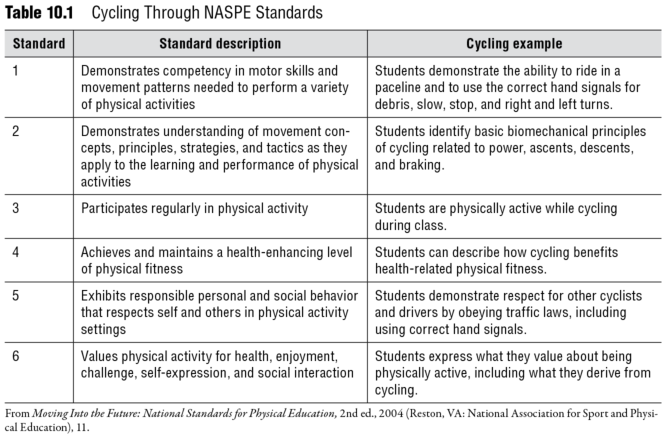|
Cycling in physical education
This is an excerpt from Teaching Lifetime Outdoor Pursuits edited by Jeff Steffen and Jim Stiehl.
|

The following is a list of benefits that result from including cycling in the physical education curriculum:
- There is much that can be learned while cycling, some of which is perfect for integrating science (identifying flora and fauna of the local area), mathematics (calculating distance and speed), geography (mapping), social studies (studying the historical significance of cycling in different societies), language arts (reading and writing about cycling), environmental science (reduction of emissions by cycling), and more.
- Cycling helps students to meet each and every NASPE standard for physical education. Table 10.1 provides only one example of how cycling meets each standard; the cycling lessons on the accompanying CD-ROM include more on how cycling helps students to meet NASPE standards.
- There is a natural fit between cycling and learning about health-related fitness. During cycling, students learn how to determine their target heart rate zone, how to stay in the target heart zone while riding, how to keep track of calories burned, and how to develop muscular endurance.
- Connecting a cycling unit to a local cycling event can provide students with physical activity opportunities outside of school. For example, students can complete 40 to 45 mi (64-72 km) of the 50 mi (80 km) of a half-century ride during the cycling unit in physical education and then complete the last 5 to 10 mi (8-16 km) at the event itself.
- Learning basic principles of biomechanics and physics, such as center of gravity (seat position), force production (standing versus sitting while climbing), optimal joint angles (saddle height), gear ratios (optimizing gears on a climb), and bike design (why the seat is positioned behind the crankset), provides depth to the topic.
- Some teachers have students who become trained as bike mechanics and establish their own bike shop in the school.
- Students can become proactive citizens for personal, community, and environmental health while engaged in a cycling unit. Conducting a bikeability survey of the local community or area surrounding the school can encourage students to become more aware of the needs of cyclists and to become more civic minded. Students can encourage people in the community to cycle more during National Bike Month, which typically is May and includes the designated Bike to School or Work Week.
- Middle and high school students can buddy up with and mentor elementary school students through a cycling education program. This program might include helping the younger students to travel safely between home and school.
- And, of course, just learning about bikes, bike maintenance, and riding safely and efficiently provides a good deal of learning material!

Clearly there are many benefits to incorporating cycling into a physical education curriculum. So what are the potential challenges, and how might a teacher overcome such challenges? First and foremost, it is a teacher’s knowledge, attitude, and willingness to accept and surmount challenges that make implementing outdoor activities possible. In a recent study of 10 physical education teachers who implemented various outdoor activities at secondary schools, McNamee and Timken (in review) found that each teacher faced multiple barriers when offering nontraditional outdoor pursuits (e.g., mountain biking, rock climbing, backpacking, cycling). Funding, space (including storage), time, and scheduling were common barriers. Nonetheless, these 10 teachers forged ahead, most often because of the benefits to students, but also for themselves. Various tips on getting started for teaching cycling are provided in figure 10.1. No doubt there are more challenges to teaching cycling than there are to teaching badminton in physical education, but the motivation to continue teaching outdoor activities often comes from the positive reactions the students have to learning something new.


|
|